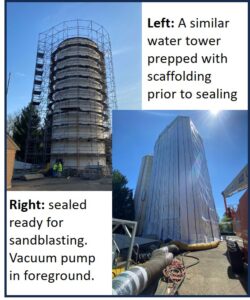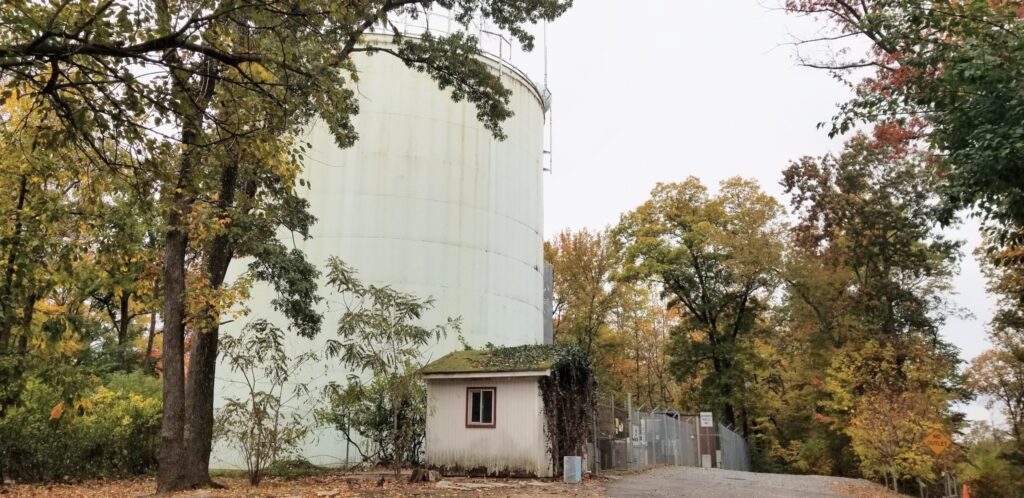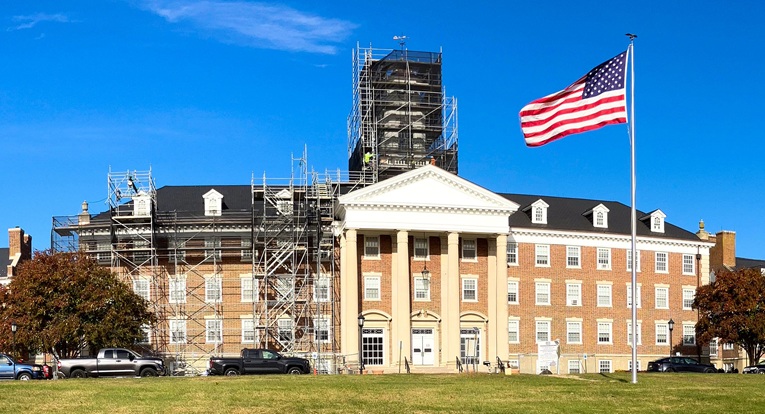At its October 15 worksession, Greenbelt City Council heard a Washington Suburban Sanitary Commission (WSSC) report on renovation of the current standpipe (also referred to as the water tower) at Lastner Lane and Ridge Road. With preliminaries complete and a contractor on board, WSSC now expects to move ahead in November. The tower dates from 1936 and is about 83’ tall and 69’ in diameter and holds approximately two million gallons. It will be stripped of previous coatings inside and out and recoated. Ancillary equipment and storage will be replaced and controls updated.
WSSC Project Manager Christopher DeHerde described the many steps so far, including the bond process, advertising for bids and a possible temporary tower for T-Mobile – which has now been deemed unnecessary. Drawings and other information are shown in a presentation package at https://tinyurl.com/24r5ezbk.
Keeping Up Appearances
The water tower lot is owned by the city. The house at 241 Lastner Lane will be demolished (it was in foreclosure before being purchased by WSSC) and the site will become a landscaped area, including a pollinator garden, adjacent to Lastner Lane. Plants will include 69 bushes and other plants to screen the fence. Large trees are out due to potential damage and security concerns but smaller native trees are included.
Fencing will be installed when erosion and sediment control provisions are complete, at about 25’ from the Lastner Lane sidewalk using black-coated chain link fence with no barbed wire for a more residential vibe.
First Steps
The project will first demolish the house and sheds and replace fencing and piping. There will be structural steel upgrades and foundation repairs, and Occupational Safety and Health Administration (OSHA) upgrades to railings and ladders.
Then the standpipe surface will be abrasively blasted and a series of coatings applied to prevent corrosion, as will the tank interior.
Work hours will be 7:30 a.m. to 5 p.m. with potential Saturday work with WSSC approval but not regularly, and deliveries will be made outside school pickup and drop-off times. No impact is expected to customer water supply except at reconnection (see below).

Methodology
As shown in the two photographs of a similar tower undergoing the same process, the standpipe cylinder is first encased in rigid scaffolding and sealed into a flexible covering to contain the sandblasting environment. Debris and dust are removed via a vacuum system that draws clean air in one side and sucks the dirty air out through filters to trap particulates. It’s like working inside a giant vacuum cleaner. Worker health and safety is to comply with state and federal OSHA standards.
Noise Concerns
DeHerde, answering a question by Mayor Emmett Jordan, agreed that sand blasting is loud and, in answer to him and Councilmember Jenni Pompi, explained that because the process is weather-dependent (dew point, humidity, temperature) each of the two sandblasting work phases (exterior and interior) would likely spread over two months.
Waste Disposal
In response to Councilmember Rodney Roberts’ question about debris, the contractor representative replied that the disposal site for sandblasting waste would depend on whether it is classified as hazardous. If hazardous, it would be disposed of in accordance with hazardous material regulations. If not, it could go to any landfill.
The existing exterior coating has been sampled and likely contains lead, but typically the coating on the interior of the tank does not contain lead. Waste streams are separated, documented and handled accordingly.
Demolition of the house at 241 Lastner Lane in front of the tower involves both lead paint and asbestos abatement which will conform with county and city requirements. Contractor Titan Industrial Services is a qualified lead abatement contractor with all required local and national certifications and will employ a local subcontractor to perform the demolition.
Paint Finishes
The tank exterior is then painted. The first coat is a zinc-based primer which acts as a “sacrificial coating” (Roberts remarked that it was like zincing the hull of a boat). If moisture were to get through to it, the zinc layer would corrode before moisture got past it, extending the life of the steel tank beneath. Titan Project Manager Nick
Moshonisiotis noted that this was a highly-engineered paint system and he expects it to last 20 to 25 years or longer.
Paint designs for the refurbished tower are green-oriented, and Jordan mentioned the possibility of polling residents to choose, though Councilmember Kristen Weaver noted that the tower is barely visible from the street. Sketches are provided in the presentation material at https://tinyurl.com/t5pmwkde.
Water Pressure
WSSC Systems Control Group Division Manager Karen Wright, responsible for water supply countywide, responded to resident Melanie Cantwell’s question about water pressure – which residents on Julian Court, close to the tower, consider poor. Wright explained that the pressure was set across a wide area by the overall elevation of the water source and the water supply is not dependent on the standpipe. Refurbishing the standpipe does not impact its geometry and will not change the water pressure which is lower at higher elevations.
Wright said the water tower is only one storage element in a much wider context, which the water supply for Greenbelt is integrated with, at the same pressure as approximately half of Prince George’s County. Greenbelt’s water might come from any source available to the county. Domestic water pressure is balanced to provide at least the minimum statutorily required pressure at the highest points in the county without flipping faucets off facilities further downhill. Greenbelt’s water may even come from the Potomac River. Roberts smilingly expressed a deep aversion to Potomac water.
Project Schedule
The project is expected to start this fall and complete in early February 2027. Demolition of the house comes first, in early to mid-November. Cantwell – the water tower is right behind her house – spoke on behalf of herself and her neighbors. She wondered how weather-dependent the project schedule would be.
Moshonisiotis replied that weather considerations are built into the schedule; coating application is weather-dependent, but the multitude of things to be done means that when they can’t coat, there are other activities that can be done to use the time efficiently.
Water Shutoffs and Information
Cantwell also asked whether the indication of only one likely eight-hour day of water shut off was realistic. DeHerde replied that was what is expected, although it is possible there would be a second day if there were two valves that must be dealt with separately. He confirmed that WSSC would communicate with affected residents in advance of any shutdowns and mentioned there will be a webpage coming soon on which the schedule can be viewed. Any water shut off would be for eight hours during the work day, DeHerde explained (as also noted by Wright) that the tower is one of many sources of water to Greenbelt and it would, in fact, be kept empty throughout the refurbishment. Any temporary shut off would likely occur when it was being reconnected to the main supply.
WSSC has scheduled an online pre-construction project outreach meeting for Wednesday, November 12, at 6:30 p.m. via Microsoft Teams. The link was not yet available at press time.




